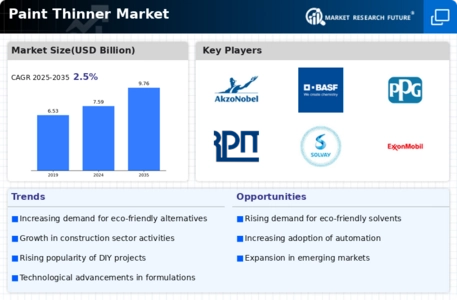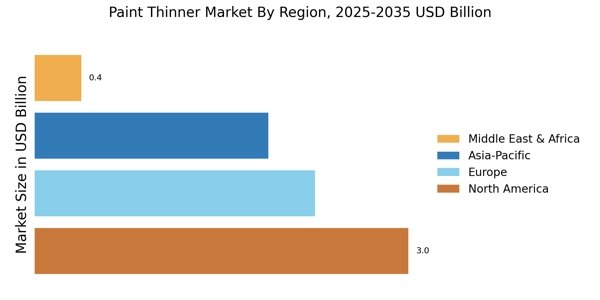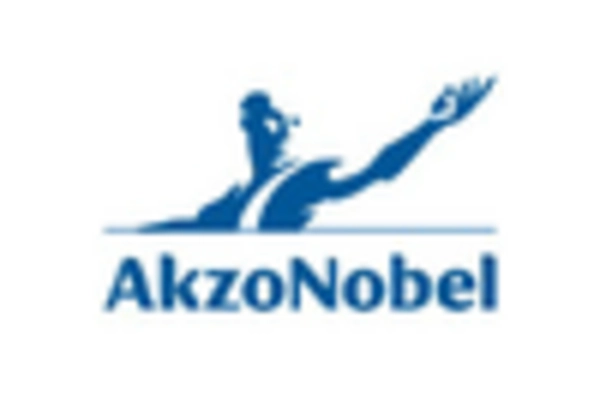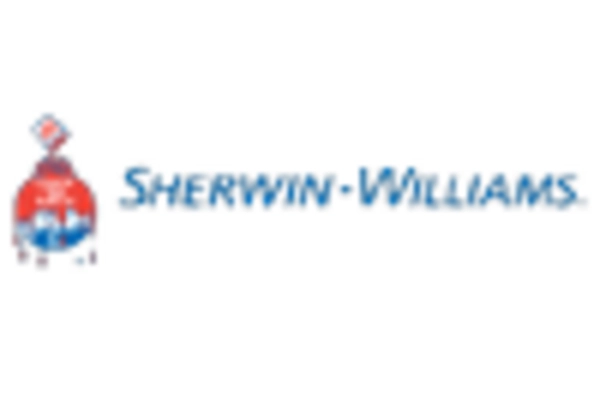Regulatory Compliance and Safety Standards
The Paint Thinner Market is increasingly influenced by stringent regulatory compliance and safety standards. Governments are implementing regulations to limit the use of hazardous chemicals in paint thinners, which drives manufacturers to innovate and develop safer alternatives. This shift not only aligns with environmental sustainability goals but also enhances consumer safety. As a result, the market is witnessing a rise in demand for eco-friendly and low-VOC (volatile organic compounds) products. In 2023, the market for low-VOC paint thinners accounted for approximately 30% of total sales, indicating a significant trend towards safer products. Compliance with these regulations is not merely a legal obligation; it is becoming a competitive advantage in the Paint Thinner Market.
Rising Demand from the Construction Sector
The construction sector is a significant driver of growth in the Paint Thinner Market. As urbanization continues to accelerate, the demand for construction materials, including paints and coatings, is on the rise. Paint thinners are essential in the application and maintenance of these materials, making them indispensable in construction projects. In 2025, the construction industry is expected to expand by 5%, which will likely lead to an increased demand for paint thinners. Additionally, the trend towards renovation and remodeling in residential and commercial properties further fuels this demand. The Paint Thinner Market is thus positioned to benefit from the ongoing growth in construction activities.
Growth of the DIY and Home Improvement Market
The DIY and home improvement market is experiencing robust growth, which significantly impacts the Paint Thinner Market. As more consumers engage in home renovation projects, the demand for paint thinners is surging. This trend is fueled by the increasing availability of online resources and tutorials that empower individuals to undertake their own projects. In 2024, the DIY segment is projected to grow by 10%, further driving the consumption of paint thinners. Retailers are responding by expanding their product offerings to cater to this burgeoning market. Consequently, the Paint Thinner Market is likely to see a sustained increase in demand as more consumers opt for DIY solutions.
Technological Advancements in Product Development
Technological advancements play a pivotal role in shaping the Paint Thinner Market. Innovations in chemical formulations and production processes are leading to the development of more efficient and effective paint thinners. For instance, the introduction of bio-based thinners is gaining traction, appealing to environmentally conscious consumers. Furthermore, advancements in manufacturing technologies are enabling companies to produce high-quality thinners at lower costs, thereby enhancing profitability. In 2024, it is projected that the market for bio-based paint thinners will grow by 15%, reflecting a shift towards sustainable solutions. These technological developments not only improve product performance but also cater to the evolving preferences of consumers in the Paint Thinner Market.
Expansion of Automotive and Industrial Applications
The automotive and industrial sectors are increasingly contributing to the growth of the Paint Thinner Market. Paint thinners are crucial in the automotive refinishing process, where they are used to thin paints and clean equipment. As the automotive industry continues to evolve, with a focus on electric vehicles and advanced coatings, the demand for specialized paint thinners is likely to increase. Moreover, industrial applications, including manufacturing and maintenance, require high-performance thinners to ensure optimal results. In 2025, it is anticipated that the automotive refinishing segment will account for over 25% of the total paint thinner consumption, highlighting the importance of these sectors in driving market growth.


















Leave a Comment